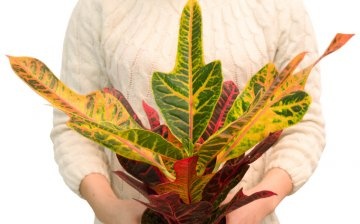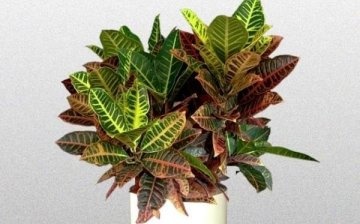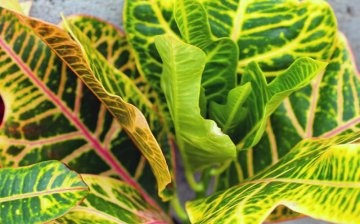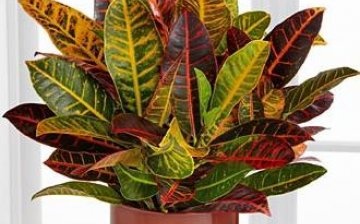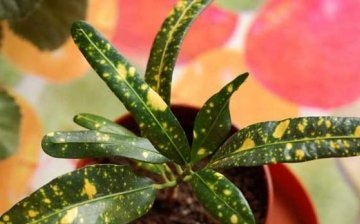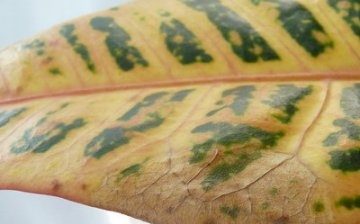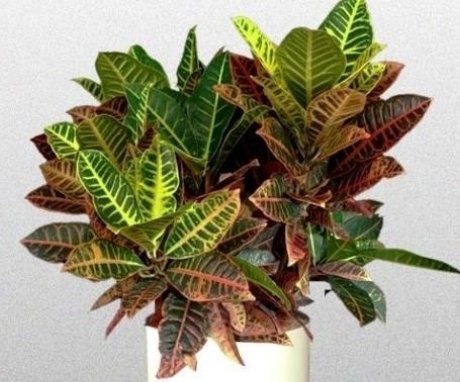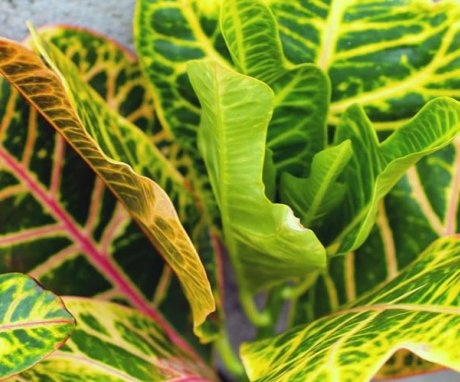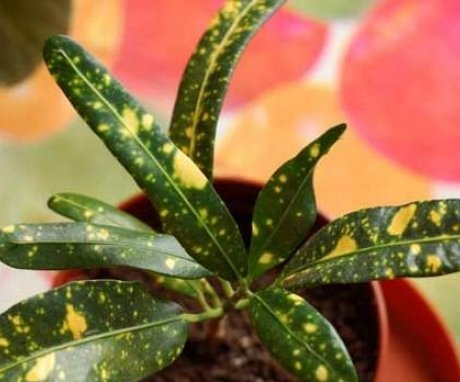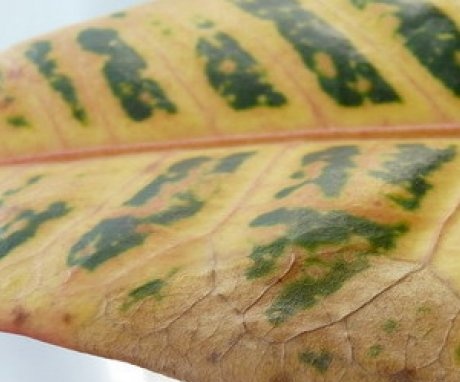Codiaum: proper plant care
The plant is gorgeous. Leaves of fabulous beauty. Will decorate any corner of the house. To preserve the health and decorativeness of the codiaum, you need to know several rules for care.
Content:
- Getting to know the plant
- We comply with microclimate parameters
- Water and feed
- We transplant and propagate
- Plant pests and diseases
Getting to know the plant
The euphorbia family. The climate of the tropics is ideal for growing. Popular varieties and types:
- Variegated codiaum... An evergreen shrub, reaching a height of up to two meters in natural conditions. Leaves on long petioles, alternate, large, shiny, leathery, colored differently: red, from green to black with a yellow tint, brown patterns. They are ovoid or linear, often with lobes. The flowers are small, the peduncle hangs down in the form of a brush.
- Painted codiaum. On long petioles, linear, alternate leaves. They can be notched and lobed, leathery. The color depends on the variety. Flowers are collected in a brush, pale yellow in color.
- The variety "Duke of Windsor" has elongated leaves with olive-red spots and orange stripes along the midrib. The lower foliage has a sharper pattern than the upper foliage.
- The variety "Mons Ernest Delarue" has a bright green leaf blade, covered with yellow spots and "golden" lines along the veins. The variety
- "Punctatum aureum" narrow lanceolate leaves, dark green with golden spots.
We comply with microclimate parameters
Humidity:
- Spray or place a humidifier in the room daily.
- In the heating season, spraying is carried out three times a day.
- A pot of water is placed in a container with expanded clay, which is constantly replenished.
- A tropical plant requires high humidity.
- Wipe the leaves weekly with a damp cloth, which enhances their brightness.
The following temperature conditions are maintained:
- The temperature of 18-22 ° C is considered comfortable for the plant.
- A decrease in temperature by 2 ° C provokes decay root system.
- Prolonged exposure to high temperatures (25 ° C) negatively affects the decorative effect of the leaves.
- Due to the sudden changes in temperature, cracks form on the leaves.
- Protect from cold air and drafts.
- It is undemanding to the light mode.
- Diffused sunlight contributes to the preservation of decorative properties and full development.
- The western and eastern directions of the windows are comfortable for him. The use of floor stands is possible.
- They darken on the southern windows. In bright light, variegated varieties change color.
- In the winter months, with a lack of sunlight, they are transferred to the south window or artificially illuminate.
Water and feed
Watering depends on the following parameters:
- Regularity. Otherwise, the plant will shed its foliage.
- Water quality. Water that must have stood for at least a day, at room temperature. Codiaum sheds leaves from cold water.
- Watering frequency. Watering is carried out when the upper layer of the substrate dries up (no deeper than 2 cm).
- Temperature. At high - watering is plentiful, at low - moderate.
- Humidity. At high air humidity, there should be no stagnation of water.
- Introduce weekly for the entire growing season. In winter, they are fed once a month.
- Top dressing is applied after watering, and not before it.
- Choose a preparation composition, which is intended for decorative deciduous plants.
- Dissolve the strictly defined dosage indicated on the container.
We transplant and propagate
The plant is transplanted annually. They buy soil for decorative deciduous plants in a flower shop, the pH of the substrate is 5.5 - 6.8. Choose a pot that is wide, but shallow, with a 3 cm drainage layer at the bottom.
The plant is carefully rolled over so as not to damage the root system.
A small amount of earth is poured onto the drainage layer, a deepening is made, the plant is transferred into it and sprinkled with earth on the sides. Shoots and branches are pruned to form a bush. The codiaum procedure is painless. Pruning is carried out in the spring. Removed shoots are used for cuttings... During manipulations, the plant secretes juice. It is poisonous and causes vomiting, diarrhea and skin lesions (dermatitis). Precautions must be taken.
Reproduction of colium:
- Cutting the tops. With the onset of warm spring weather, cuttings up to 15 cm long are cut with a knife. The leaves are tied to the trunk in the form of a tube and planted. The seedlings are placed in greenhouse conditions. Plants are ventilated daily and sprayed with water. Within a month, the root system will form. The use of the growth stimulator "Kornevin" is recommended.
- Air layering. Press the branch to the ground and fix it, sprinkling it with earth on top. At the branch, the lower edge is cut and processed with a rooting agent. As soon as the root is formed, the branch is cut off from the mother and planted in another pot.
- Seeds... Sowing is carried out only with freshly harvested seeds in January – February. Before sowing, it is soaked for 3 hours in a solution with phytohormones. Sow in containers with soil, deepening by 1 cm. Apply bottom watering and maintain the optimum temperature. Seeds sprout after a month. With the appearance of the third leaf, it is seated in pots of small diameter (up to 7 cm).
For young plants, the same microclimate parameters are observed as for adult plants. For active growth of leaves, the drug "Zircon" is added to the water for irrigation or spraying.
Plant pests and diseases
Red spider mite is a red pest. It feeds on plant juices, which leads to their wilting and death. Parasitic signs:
- The leaves are covered with spots of yellow and red.
- Colonies of mites on the lower surface of the leaves appear as white spots.
- A close examination of the codiaum will reveal the presence of small white cobwebs.
The reasons for the appearance of the pest:
- Low air humidity.
- The accumulation of water between the leaves of the plant and in its core.
- Irregular removal of faded and wilted parts of the plant.
Control measures:
- Wash all parts of the plant with soapy water. This will reduce the number of ticks.
- Spill the soil abundantly and cover tightly with cellophane for 3 days. High humidity is harmful to pests.
- They are treated with acaricidal and insecticidal preparations: Apollo, Sunmayt, Floromite, Akarin, Aktofit, Agravertin, Kleschevit, Vermittek, Fitoverm.
More information can be found in the video:
It is not difficult to recognize the shield. Small insect up to 5 mm, has a shell. Initially, they parasitize on young shoots, killing them, which will mix on adult leaves and stems. Cell sap is sucked out of the plant, and it dies. Parasitic signs:
- The presence of honeydew (sticky liquid) on the leaves.
- The parasite hides at the junction of the leaf shank with the trunk. You can see it.
- The appearance of specks on the leaves.
Reasons for the appearance:
- The eggs of the scale insects remain in the ground, in the water.
- The plant was acquired by the sick.
Control measures:
- Application of chemicals: Aktar, Akteplik, Bankol.
Diseases of the codiaum:
- Leaves have brown tips and / or fall off. Reason: low air and soil humidity.
- The edges of the leaves are brown. Cause: The room temperature is low.
- Loss of leaf color. Reason: lack of light.
The codiaum has earned a special attitude towards itself due to the magnificent color of its leaves, which distinguishes it from other indoor plants. But as beautiful as it is poisonous! It is necessary to give him a place inaccessible to children. The florist himself should work with him with gloves and be careful.



